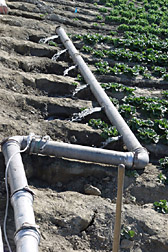This page has been archived and is being provided for reference purposes only. The page is no longer being updated, and therefore, links on the page may be invalid.
Read the magazine story to find out more. |
|
Research Aims to Improve Fertigation for Farmers
By Jan SuszkiwNovember 10, 2004
Getting the most from fertigation--nourishing crops with water and chemical fertilizers simultaneously--using different irrigation systems is the goal of Agricultural Research Service scientists seeking to devise best management practices for farmers.
Fertigation's advantages include a capacity to nourish crops throughout the season using less nitrogen and other fertilizers. Despite reducing time and costs associated with irrigating and fertilizing crops separately, fertigation still has room for improvement. One area ARS scientists are working on is delivery--putting nutrients where they're needed and at adjustable rates.
At the ARS U.S. Water Conservation Laboratory in Phoenix, Ariz., soil scientist Floyd Adamsen and agricultural engineer Douglas Hunsaker are identifying the optimal timing of mixing fertilizer with irrigation waters. In a study with date palms on sandy soils in California's Coachella Valley, the scientists observed that the fertilizer applications were most uniform when the fertilizer was added during the entire irrigation process, rather than for part of it.
In Lincoln, Neb., at the ARS Soil and Water Conservation Research Unit, research leader Jim Schepers and colleagues are testing the use of high-clearance canopy sprayers equipped with electronic sensors. For example, prior to fertigation, the sensors zap the crop with certain light wavelengths to check for the onset of stress due to nitrogen deficiency. The sensors then assign a numeric value to the returning light. The canopy sprayers use this information to fertigate with variable rates of nitrogen based on the plants' needs, saving money and reducing the risk of leaching surplus nutrients.
David Bryla, a plant physiologist formerly with the ARS Water Management Research Laboratory in Parlier, Calif., tested the use of subsurface drip-irrigation systems to fertigate newly planted peach trees. Through subsurface tubes, the system delivered precise amounts of water and fertilizer directly to the trees' roots in a highly efficient manner, according to Bryla, now at the ARS Horticultural Crops Research Unit in Corvallis, Ore.
Read more about fertigation research in this month's issue of Agricultural Research magazine.
ARS is the U.S. Department of Agriculture's chief scientific research agency.

